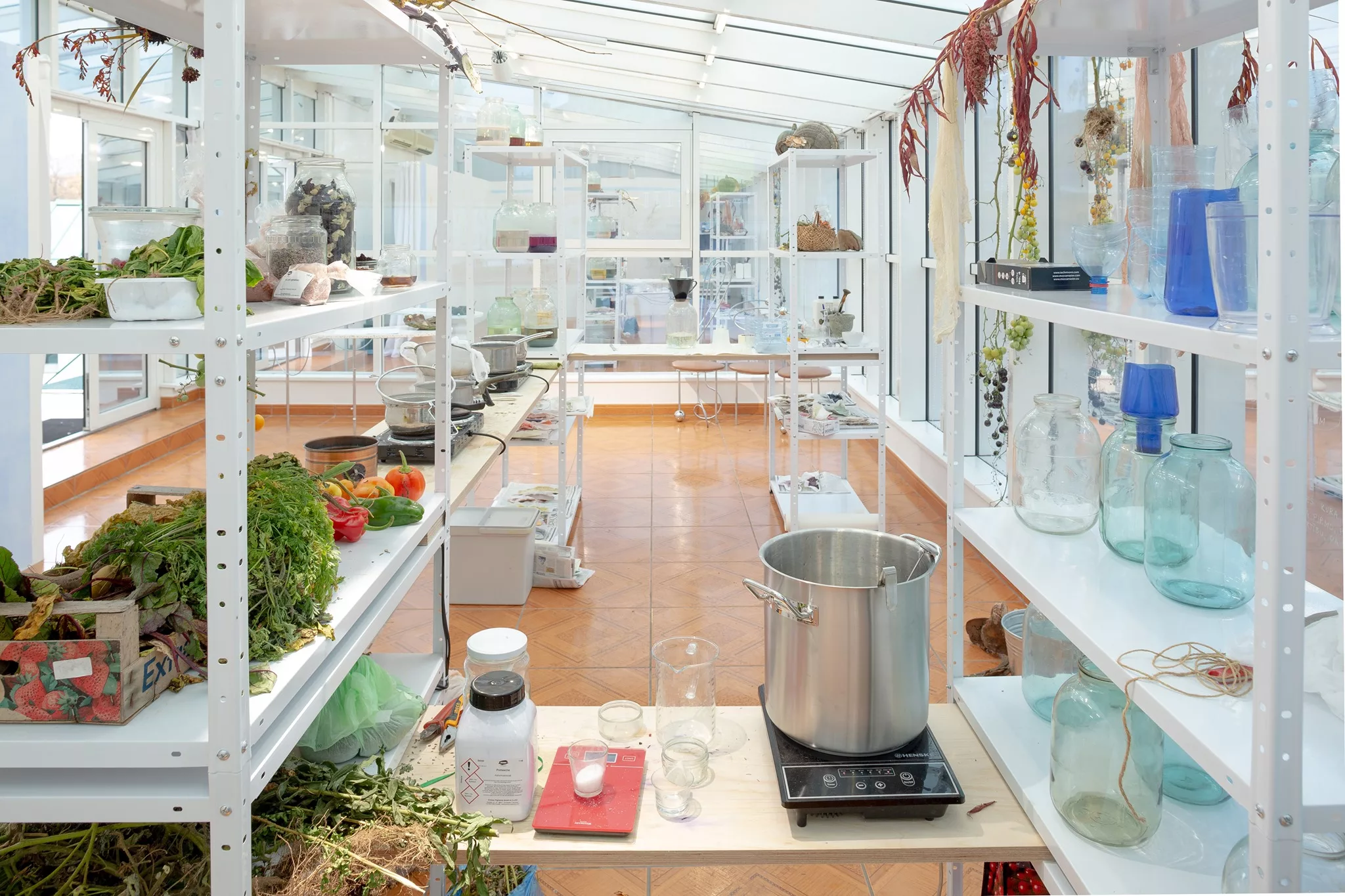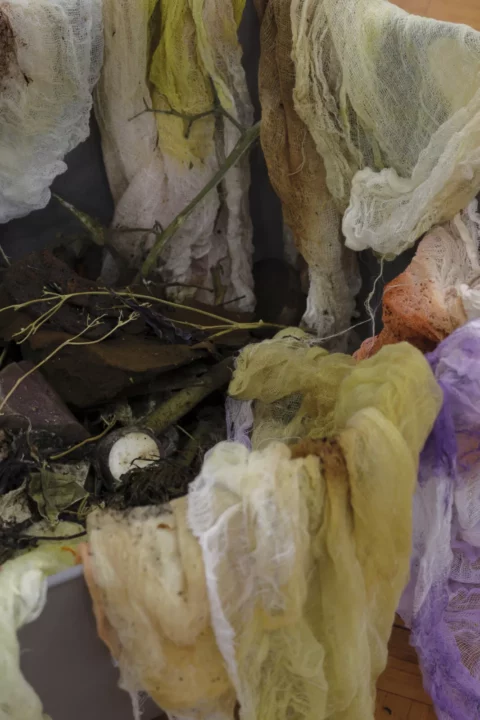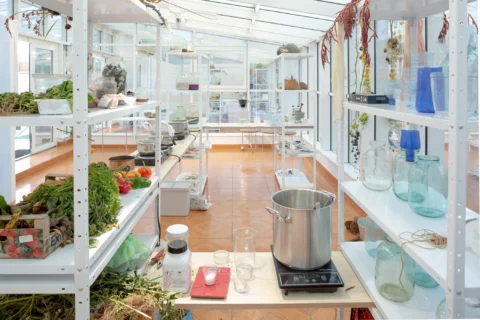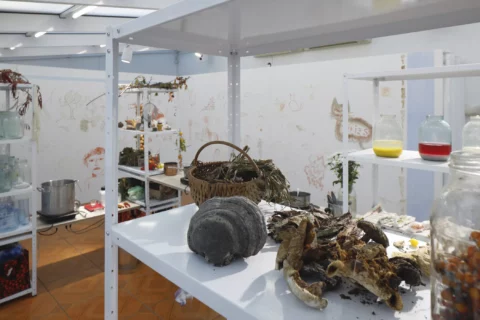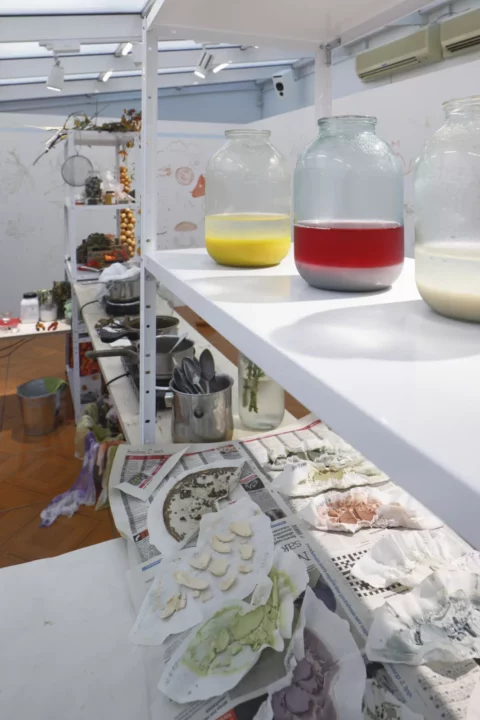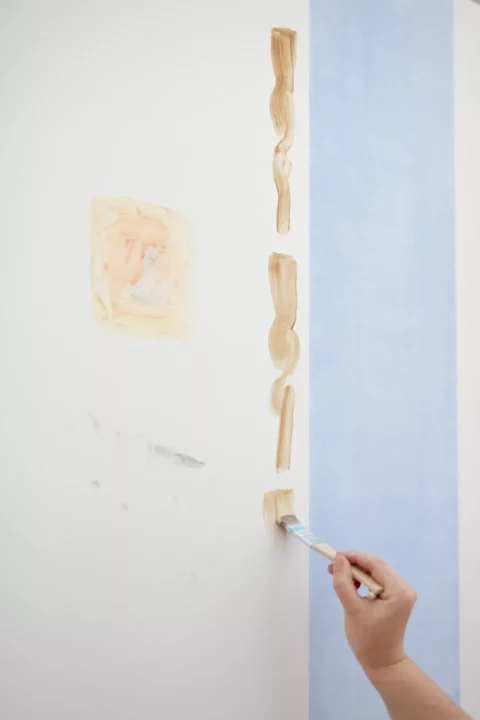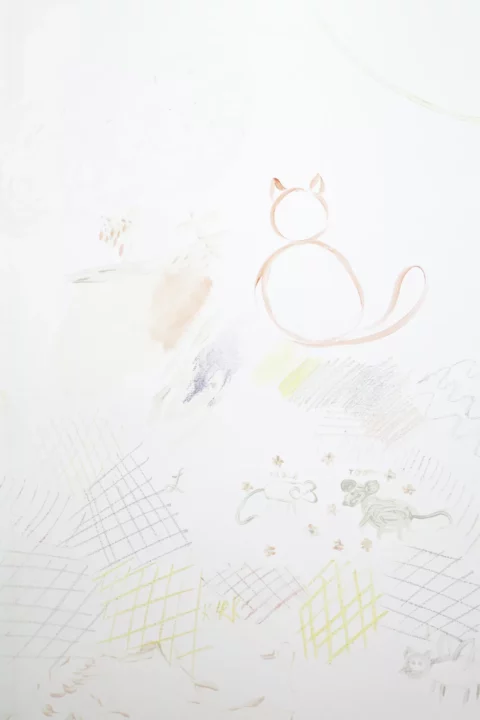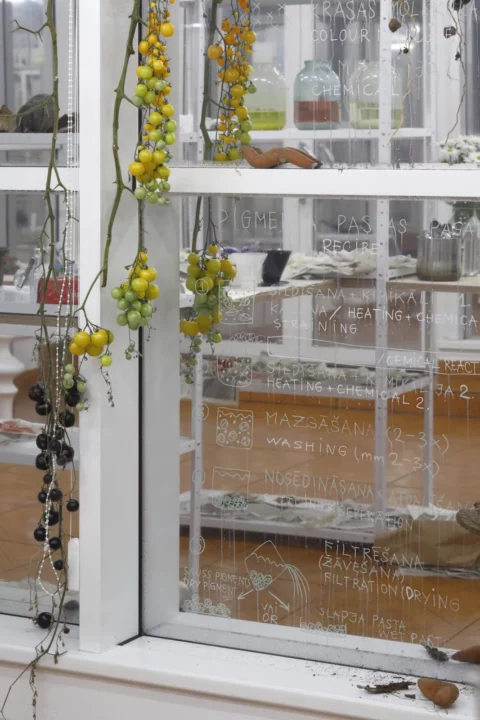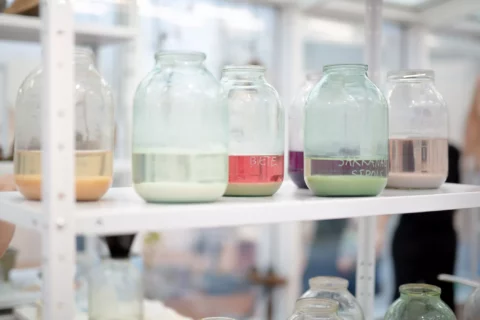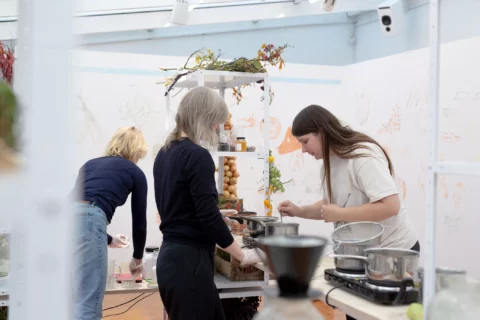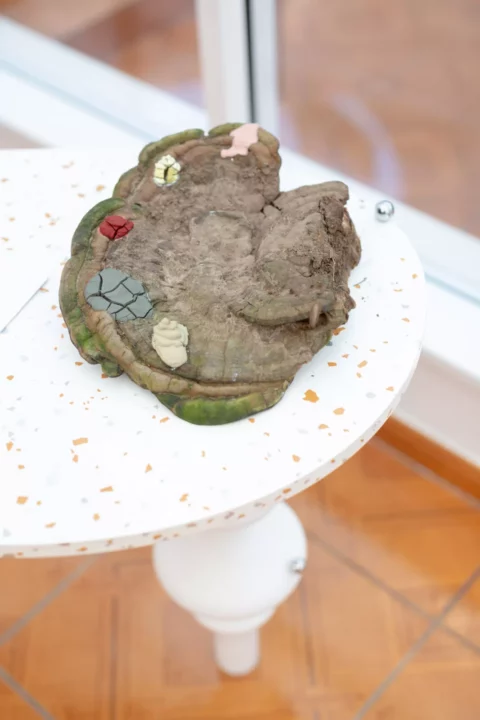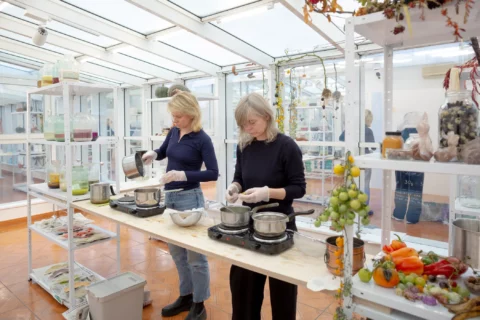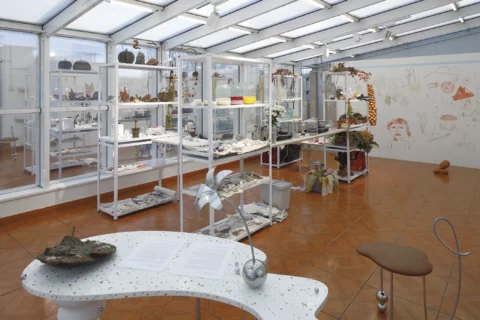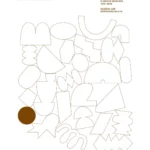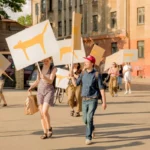At the very center of the exhibition, there is an improvised laboratory. Under the guidance of the artists, visitors were invited to participate in the process of extracting pigments from natural materials and trying them out on the white walls of the gallery.
The visitors acted as workshop leaders and exhibitors alongside two Finland-based painters – Inga Meldere and Emelie Luostarinen. On the opening day, Emelie Luostarinen shared a brief reflection: a story with an encouraging message, told in English, about the magical processes of plant colour extraction and their possible interpretations.
Acquiring pigments from natural materials is a simple and exciting process and everyone is invited to join in – from professional artists and enthusiasts to nature lovers and explorers of all ages (children up to the age of 12 should be accompanied by an adult). No prior knowledge is needed to participate.
***
The creative workshop/exhibition “Ashes of a Seedling. Pigment Extraction From Natural Materials” finds its place somewhere between alternative learning pathways and a food chemistry study course, amidst equipping a modest “painter’s box” and finding a new culinary alternative, learning processes subject to marginalized industries.
Extracting pigments from natural materials is a 100% environment-friendly process in which everything that can be found on and in the ground is used as raw material to create dyes: trees, leaves, mushrooms, lichens, fruits, vegetables, roots, and flowers, combined or highlighted in a special rhythm of boiling and preparing. Whilst not that bright, the colour palette of Baltic plant pigments is incredibly nuanced. Its variations of yellow and grey are surprising and even a little enticing in their versatile monotony. The blue of the lavender effortlessly transforms into a light mint pastel whilst the red of the rowan berry becomes a pale, almost invisible ink-like substance… The result will not be an overwhelming carousel of bright, aggressive hues, but rather something akin to a meditative state of gentle and even slightly tiring intoxication.
The workshop creators intend to slowly transform the nuanced and dynamic process of pigment extraction into a visual art exhibition that encourages visitors to appreciate not only the in-person acquisition of new and useful knowledge through alternative learning methods but also its therapeutic “side effects”.
At the center of the workshop/exhibition, you will find an improvised laboratory – this is where the pigment preparation will take place. Fireproof stoves, jars of murky liquid pigments, filters, the smell of steamed plants, all of it surrounded by white gallery walls inviting you to try the freshly acquired material and create abstract smears or deliberate compositions on surfaces specially designed for this process. Newly extracted pigments will be constantly added to the exhibition. To ensure the continuity of the process, visitor participation is more than welcome.
Keywords: nature and natural materials, creation, acquiring new knowledge through practical and creative activity, recycling, sustainability, building a society that empathizes with nature, promoting and broadening the understanding of the term “care”, interdisciplinarity, intimacy, and collaboration.
Supported by VKKF, embassy of Finland, Nordic Culture Point and Saules Krasts.
Photography: Ansis Starks
10. Oktobrī galerijā LOW tika atklāta radošā darbnīca/izstāde “Dēstu pelni, jeb krāsu pigmentu iegūšana no dabas materiāliem”. Ekspozīcijas centrā atrodas improvizēta laboratorija, kurā mākslinieču vadībā skatītāji tika aicināti līdzdarboties pigmentu iegūšanā no dabas materiāliem, kā arī tos izmēģināt turpat uz galerijas baltajām sienām.
Darbnīcas vadītāju un ekspozīcijas izpildītāju lomā darbojās divas Somijā rezidējošas gleznotājas Inga Meldere un Emelie Luostarinen un darbnīcas/izstādes apmeklētāji.
Darbnīcas atvēršanas bija paredzēta neliela mākslinieces Emelie Luostarinen refleksija- stāstījums ar uzmundrinošu vēstījumu angļu valodā par augu krāsu maģiskajiem ekstrahēšanas procesiem un to iespējamām interpretācijām.
Pigmentu iegūšana no dabas materiāliem ir vienkāršs un aizraujošs process, kurā aicināti iesaistīties gan mākslas profesionāļi un entuziasti, gan dabas mīļotāji un pētnieki visās vecuma grupās (bērni pirmsskolas un skolas vecumā līdz 12 gadu vecumam aicināti piedalīties pieaugušā pavadībā). Dalībniekiem nav nepieciešamas priekšzināšanas.
***
Radošā darbnīca/izstāde “Dēstu pelni, jeb krāsu pigmentu iegūšana no dabas materiāliem”, meklējama kaut kur starp alternatīvo zināšanu apguves ceļiem un pārtikas ķīmijas kursu, starp izmaksās pieticīgas “gleznotāja kastes” aprīkošanu un jaunu pavārmākslas alternatīvu, prasmīgu, marginalizētajām industrijām pakļāvīgu, procesu apgūšanu.
Pigmentu iegūšana no dabas materiāliem ir videi 100% draudzīgs process, kurā, lai radītu krāsvielu, kā izejmateriāls tiek izmantots viss zemē un uz zemes atrodamais: koki, lapas, sēnes, ķērpji, augļi, dārzeņi, saknes un ziedi, kas apvienots vai izcelts īpašā vārīšanas ritmā. Baltijas augu pigmentu krāsu palete nav koša, bet ļoti niansēta. Dzeltenā, pelēkā variācijas ir pārsteidzošas un savā daudzpusīgajā vienmuļībā pat nedaudz uzbudinošas. Lavandas zilganums viegli transformējas gaišā piparmētras pastelī, pīlādža sarkanums – blāvā, gandrīz neredzamās tintes substancē… Rezultāts nebūs satricinošs, agresīvi uzbrūkošu krāstoņu karuselis, bet drīzāk, tuvinājums meditatīvi maigam un pat apnicīgam reibumam.
Darbnīcas veidotāju iecere ir niansētā un dinamiskā pigmentu iegūšanas procesa nesteidzīga pārtapšana vizuālās mākslas ekspozīcijā, kas rosinātu novērtēt ne tikai alternatīvās mācīšanās jaunu un lietderīgu zināšanu apguvi klātienē, bet arī tās terapeitiskos “blakusefektus”.
Radošās darbnīcas/izstādes centrā atradīsies improvizēta laboratorija, kurā norisināsies vārīšanas process. Ugunsdrošas plītis, duļķainu šķidro pigmentu burkas, filtri, tvaicētu augu smarža, gatavo pigmentu masas, baltas galerijas sienas ar aicinājumu izmēģināt nule iegūto materiālu, abstrakti triepjot vai mērķtiecīgi komponējot turpat uz īpaši šim procesam paredzētām plaknēm. Izstāde visu ekspozīcijas laiku tiks papildināta ar jaunieguvumiem – pigmentiem. Lai nodrošinātu procesa veiksmīgi ražīgu nepārtrauktību, izstādes apmeklētāji tiek laipni aicināti iesaistīties.
Atslēgvārdi: dabas un dabiski materiāli, jaunrade, jaunu zināšanu apguve caur praktisku, radošu darbošanos, otreizējā pārstrāde, ilgstspējība, dabai empātiskākas sabiedrības veidošana, termina – rūpes izpratnes paplašināšana, starpdisciplinaritāte, intimitāte un sadarbība.
Paldies VKKF, Somijas vēstniecībai, Noordic Culture Point un Z/S Saules Krasts.
